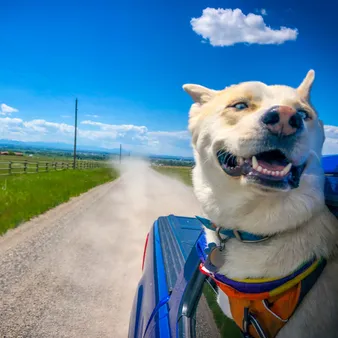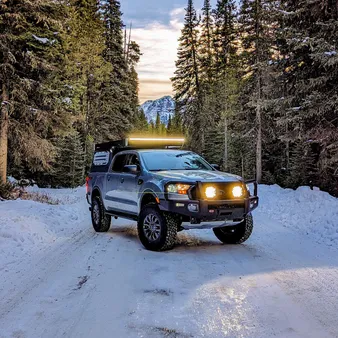Table of Contents
As a Ford Everest owner, you know that your vehicle is built for adventure. But when winter weather hits, it's important to take extra precautions to stay safe on the road. That's why we've put together this comprehensive guide to Winter Driving Tips for Ford Everest Owners. From preparing your vehicle to handling emergencies, we've got you covered. So, whether you're planning a road trip to the mountains or just commuting to work, follow these tips to stay safe and prepared this winter at Westernfordhcm.

Winter Driving Tips for Ford Everest Owners: Stay Safe on Snowy Roads
Winter Driving Tip | Description |
|---|---|
Prepare Your Ford Everest | Check tires, battery, fluids, and brakes; install winter tires if necessary. |
Essential Winter Gear | Pack an emergency kit, warm clothing, blankets, and a flashlight. |
Driving Techniques | Reduce speed, increase following distance, and avoid sudden maneuvers. |
Winter Emergencies | Stay calm, call for help, and use your emergency kit if stranded. |
Additional Tips | Use heated seats and steering wheel, clear snow and ice from your vehicle, and be aware of road conditions. |
I. Driving in Winter Weather: Essential Tips for Ford Everest Owners
Preparing Your Ford Everest
- Check tire pressure, tread depth, and condition.
- Install winter tires if necessary.
- Ensure all fluids are topped off, including antifreeze, brake fluid, and oil.
- Check battery condition and replace if needed.
- Inspect and clean all lights to ensure visibility.
Driving Techniques
- Reduce speed and increase following distance.
- Avoid sudden maneuvers or braking.
- Use four-wheel drive when necessary.
- Steer into skids and maintain composure.
- Brake gently and use engine braking.
Essential Winter Driving Gear
- Keep an emergency kit in your vehicle, including blankets, first aid supplies, and non-perishable food.
- Pack a snow shovel, ice scraper, and jumper cables.
- Bring a flashlight, extra batteries, and a portable charger for electronic devices.
Staying Safe in Winter Emergencies
- If stranded, stay calm and call for help.
- Use your emergency kit to stay warm and hydrated.
- Run the engine periodically to maintain heat, but ensure exhaust is not blocked.
- If possible, move your vehicle to a safe area.
- Inform others of your location and expected arrival time.
Additional Tips
- Use heated seats and steering wheel for comfort.
- Clear snow and ice from your vehicle thoroughly before driving.
- Be aware of road conditions and adjust your driving accordingly.
- Check weather forecasts and plan your trips to avoid hazardous conditions.
- Consider taking a winter driving course to enhance your skills.
II. Winterizing Your Ford Everest: Preparing for Safe Driving
Essential Winter Driving Gear
Pack an emergency kit that includes warm clothing, blankets, a flashlight, and a first-aid kit. Consider adding a portable jump starter and a set of tire chains for added peace of mind.
Driving Techniques for Winter Conditions
Reduce your speed and increase your following distance to give yourself more time to react to changing conditions. Avoid sudden maneuvers and be gentle with the accelerator and brakes.
Winter Driving Tip | Description |
|---|---|
Reduce Speed | Slow down to give yourself more time to react to changing conditions. |
Increase Following Distance | Leave more space between you and the car in front of you to avoid collisions. |
Avoid Sudden Maneuvers | Be gentle with the steering wheel and avoid making sudden movements. |
Use Gentle Acceleration and Braking | Apply the accelerator and brakes smoothly to avoid losing control. |
Staying Safe in Winter Emergencies
If you get stranded in a winter storm, stay in your car and call for help. Run the engine periodically to stay warm, but keep a window slightly open to avoid carbon monoxide poisoning.
- Ford Everest vs. Toyota Fortuner: Head-to-Head Comparison
- Exploring the Interior Features of the Ford Everest
Additional Tips for Winter Driving
Use your heated seats and steering wheel to stay warm and comfortable. Clear snow and ice from your vehicle thoroughly before driving, and be aware of road conditions before you set out.

Winterizing Your Ford Everest: Preparing for Safe Driving
III. Winter Driving Techniques for Enhanced Safety
Driving in winter conditions requires extra caution and preparation. By following these techniques, you can enhance your safety and reduce the risk of accidents during the colder months.
Plan Your Route and Check Weather Updates
Before setting out on a journey, check the weather forecast and road conditions. If there is heavy snow, ice, or fog, consider postponing your trip if possible. If you must drive, plan your route carefully and allow yourself extra time to get to your destination.
Tip | Description |
|---|---|
Check weather updates | Stay informed about forecasted snow, ice, fog, and wind. |
Plan your route | Choose roads that are well-maintained and avoid mountain passes or isolated areas. |
Allow extra time | Factor in potential delays caused by snow, ice, and traffic. |
Reduce Speed and Increase Following Distance
In winter conditions, reduce your speed and increase your following distance. Snow and ice can significantly reduce traction, making it harder to stop or maneuver your vehicle. Allow plenty of space between you and the car ahead to give yourself time to react to sudden changes in road conditions.
- Reduce speed by 10-15 mph below the posted limit.
- Increase following distance by at least triple the usual recommended distance.
- Avoid sudden braking or acceleration, as this can cause your vehicle to skid.
IV. Emergency Preparedness: What to Do When Winter Conditions Strike
Winter driving can be unpredictable, and it's important to be prepared for any situation. If you're stranded in your Ford Everest during a winter storm, it's crucial to stay calm and follow these steps to ensure your safety.
First, pull over to a safe location if possible. Turn on your hazard lights and stay inside your vehicle. Call for help immediately by dialing 911 or using your cell phone. If you have a roadside assistance plan, contact them as well.
Emergency Preparedness Checklist | Description |
|---|---|
Stay calm and assess the situation. | Pull over to a safe location if possible. |
Call for help immediately. | Dial 911 or use your cell phone. |
Use your emergency kit. | Stay warm and hydrated. |
Stay informed about weather conditions. | Listen to the radio or check online for updates. |
Be patient and wait for help to arrive. | Do not attempt to walk or drive in dangerous conditions. |
While you wait for help to arrive, stay warm and hydrated by using your emergency kit. Eat non-perishable snacks and drink plenty of water. If you have blankets or extra clothing, put them on to stay warm. It's also important to stay informed about weather conditions by listening to the radio or checking online for updates.
Finally, be patient and wait for help to arrive. Do not attempt to walk or drive in dangerous conditions. If you must leave your vehicle, make sure to dress warmly and take your emergency kit with you. By following these tips, you can stay safe and prepared during any winter emergency.
For more information on winter driving safety, please visit our website at westernfordhcm.com.vn.
V. Conclusion
By following these winter driving tips for Ford Everest owners, you can increase your safety and preparedness on the road during the colder months. Remember to prepare your vehicle, pack essential gear, adjust your driving techniques, and stay calm in emergencies. With a little planning and caution, you can navigate winter driving conditions with confidence. Stay safe and enjoy the journey!